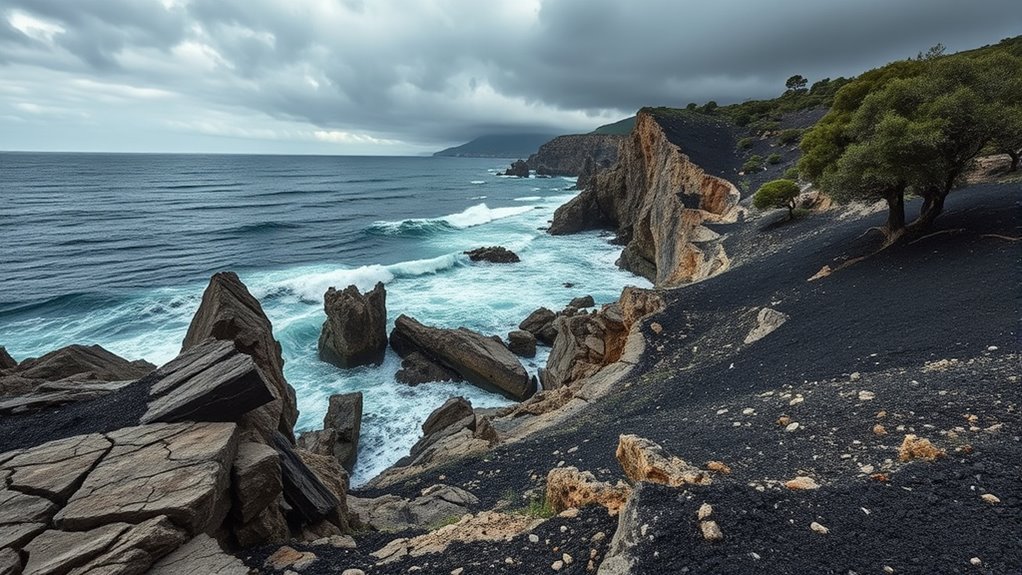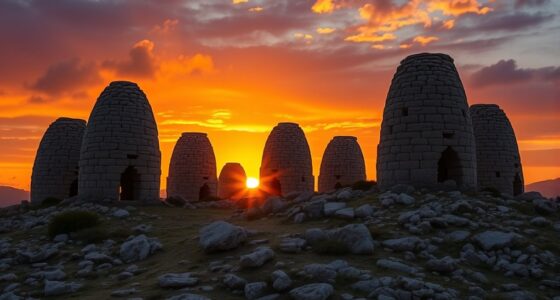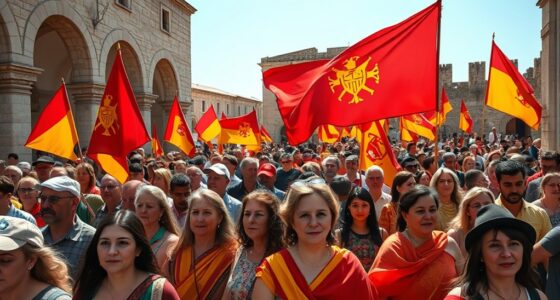Historically, Sardinia has experienced relatively few natural disasters, but wildfire outbreaks, floods, and minor earthquakes have occurred over the centuries. Major wildfires, like the 2021 Montiferru event, caused significant damage and evacuations, often linked to human activity or drought conditions. The island’s geology is stable, resulting in low seismic risk, though some floods and landslides have affected communities. To uncover more about these events and Sardinia’s resilience, there’s more to explore below.
Key Takeaways
- Sardinia’s most significant historical natural disasters include rare earthquakes, major floods, landslides, and devastating wildfires.
- Notable earthquake events occurred in 1616 and 1771, with limited local damage due to regional stability.
- Wildfire incidents, while frequent, have predominantly caused ecological damage; the 2021 Montiferru wildfire burned over 20,000 hectares.
- Floods in Sardinia, such as the 2013 Olbia event, have resulted in fatalities and infrastructure damage.
- Overall, Sardinia experiences fewer and less severe natural disasters compared to mainland Italy.
Wildfire Incidents and Fatalities Over the Years
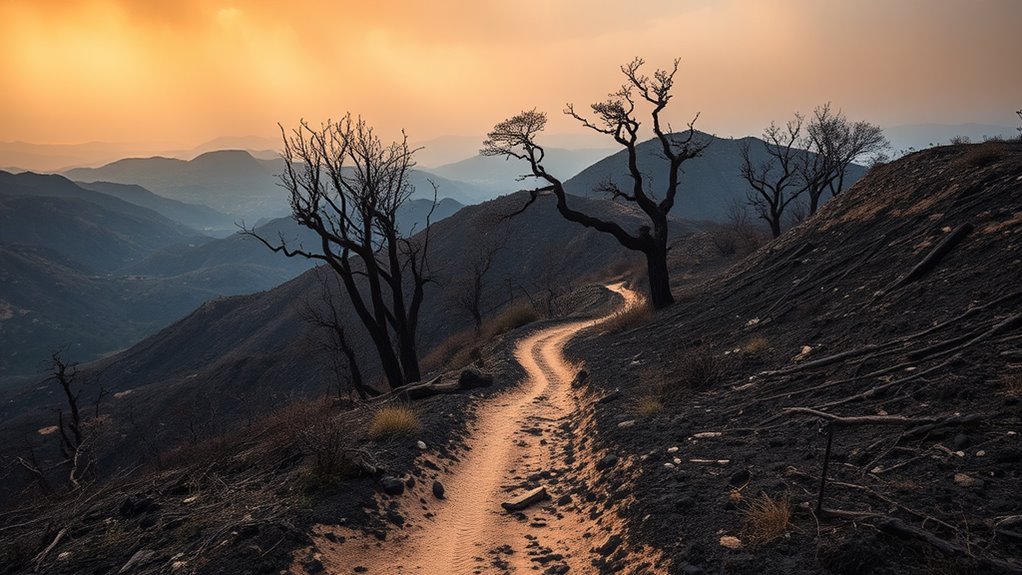
Over the years, Sardinia has experienced a high frequency of wildfire incidents, averaging around 2,500 fires annually between 1995 and 2009. During this period, about 17,000 hectares are burned each year, mostly from June to September, peaking in July. Most fires are small, averaging 7 hectares, but larger fires over 100 hectares account for roughly 60% of the total area burned. While specific data on fatalities is limited, wildfires pose significant risks to people, especially in high-activity areas. Human activity, climate factors, and land use changes contribute to the fire risk. Public safety measures, emergency responses, and prevention strategies aim to reduce casualties and contain incidents, but the threat remains a constant concern for communities across Sardinia. Ourmindandbody.com offers additional resources on wildfire safety and prevention strategies.
Major Wildfire Events and Their Impact

Major wildfire events in Sardinia have caused devastating ecological, economic, and social consequences. In 2021, the Montiferru wildfire burned over 20,000 hectares, destroying pastures, olive groves, and barns, damaging local agriculture and livelihoods. The loss of ancient olive trees, including the iconic millennial olive of Sa Tanca Manna, symbolized cultural tragedy, though some believed it might survive. Livestock habitats and enclosures were also destroyed, intensifying economic pressures on farmers. Environmentally, these fires damaged forests, increased erosion, and fragmented habitats, threatening biodiversity. Socially, about 1,500 residents were evacuated from high-risk zones, with thousands of emergency personnel battling flames using aircraft and ground efforts. Property losses, including homes and infrastructure, further compounded the crisis, leaving lasting scars on Sardinia’s landscape and communities. Wildfire impact has long-term effects on ecosystems and local economies, highlighting the importance of effective prevention and response strategies.
Causes and Contributing Factors of Sardinian Wildfires
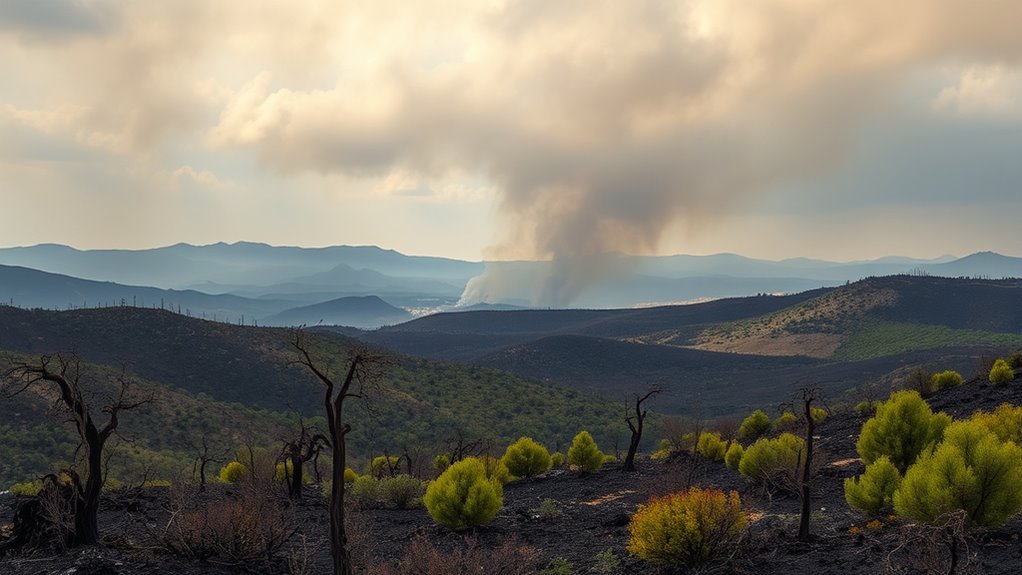
The causes behind Sardinia’s frequent wildfires are complex, with human activities playing a significant role. About 53% of fires are intentionally set, often linked to agricultural practices like stubble burning and using fire as a rural tool. Nearly half of the wildfires (around 46%) result from negligence, such as improper control of open flames, machinery, or equipment during farming. Many fires are worsened by noncompliance with fire prevention regulations, especially in rural areas. Additionally, a large portion of fires (roughly 78%) have unknown causes, making prevention difficult. Human ignition patterns peak in summer, particularly late July, when dry vegetation and high temperatures create ideal conditions for fire spread. Expert perceptions highlight that human-related factors are the primary motives for wildfires in Sardinia. Overall, human behaviors—both deliberate and accidental—are central to wildfire occurrence and severity in Sardinia, emphasizing the importance of fire prevention and education efforts.
The Myth and Mystery of the Ancient Catastrophic Event
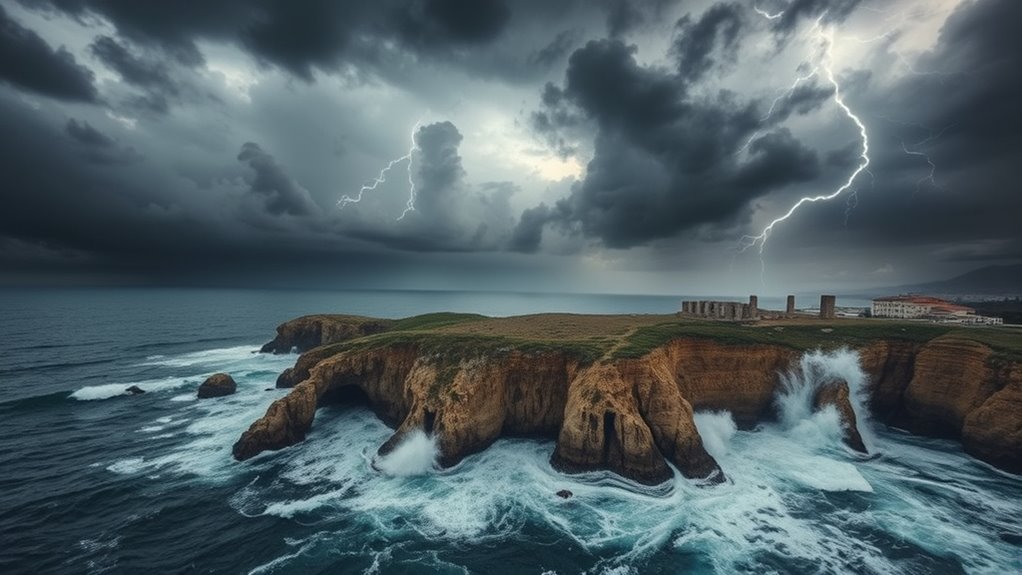
You might wonder if natural forces like comet impacts or massive tsunamis caused Sardinia’s ancient destruction. Some believe these events inspired myths such as Atlantis, blending fact with legend. Exploring these stories helps uncover the true scale and mystery of what truly happened. Recent scientific findings supporting the comet impact theory suggest that a sudden, catastrophic event drastically altered Sardinia’s landscape and its ancient civilization. The archaeological record further hints at sudden, widespread destruction that corresponds with these theories.
Possible Natural Causes
Ancient Sardinia’s history is marked by dramatic natural events that may have reshaped its landscape and society. Around 16 million years ago, the Sardinia-Corsican block separated from the Provençal coast, triggering tectonic movements that created fractures and faults. These shifts caused magma rises and intense volcanic activity, including explosive eruptions that deposited ash and lapilli across large areas, similar to Pompeii’s eruption. Volcanic processes formed notable igneous rocks like basalt and rhyolite, visible today. Past climate fluctuations, with colder glacial periods, contributed to frost weathering and rock fracturing. Coastal instability and rockfalls, driven by climatic and geological factors, added to ongoing hazards. Additionally, ancient volcanic activity, including possible impacts like a comet around 1175 BC, could have generated massive tsunamis, devastating Sardinia’s early civilizations. The island’s volcanic past has left behind a landscape prone to natural hazards, which may have played a role in shaping its historical narratives of disaster. Moreover, the tectonic activity associated with these geological processes continues to influence the region’s seismic vulnerability today.
Mythical Interpretations
Many theories link Sardinia’s mysterious past to legendary catastrophes, blending myth with history to explain its ancient ruins and vanished civilizations. You might see Sardinia as the lost homeland of Atlantis, with myths describing divine punishment through floods or tidal waves, sometimes over 500 meters high. Legends tie gods like Poseidon to natural disasters, framing Sardinia’s fall as a divine reset. The Nuragic civilization’s warrior and seafaring reputation fuels myths of invasions by the Sea Peoples, especially the Sherden tribe. The Giants of Mont’e Prama symbolize heroic figures connected to this turbulent history. These stories weave a mythic narrative of destruction and rebirth, echoing across Mediterranean legends and shaping Sardinia’s timeless mystery. The archaeological remains of Sardinia continue to inspire both scholarly research and mythic storytelling, emphasizing the island’s enduring allure and enigma.
Geological Stability and Seismic Activity in Sardinia
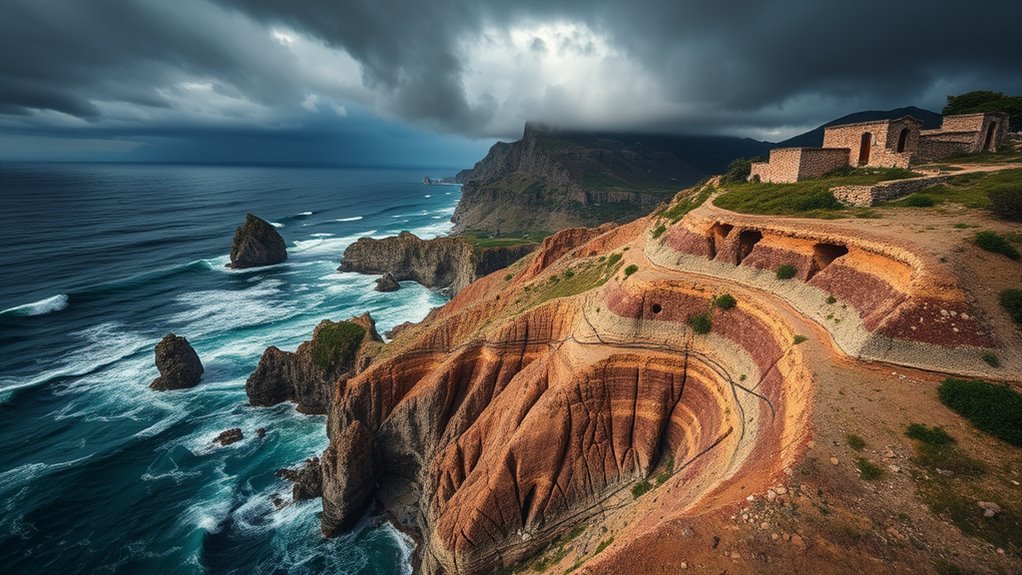
You might assume Sardinia is prone to earthquakes, but its geological history tells a different story. The region is considered one of Italy’s most stable, with very few significant seismic events recorded over centuries. This stability means that, while rare tremors can occur, the island generally faces a low seismic hazard. Since 2025, Sardinia experienced only 22 quakes up to magnitude 3.3, indicating the region’s seismic activity remains infrequent and minor. Additionally, geological surveys highlight the region’s tectonic stability, further supporting its reputation for low seismic risk.
Low Seismic Hazard
Sardinia’s geological stability plays a key role in keeping seismic activity low across the island. Its stable geological structure makes it one of the safest regions in the Mediterranean for earthquakes. The seismic hazard level is generally low, with rare but possible earthquakes occurring. Sardinia is classified as a low hazard zone (Zone 2), reflecting its minimal risk. While tectonic movements can trigger occasional quakes, most are of low magnitude and cause little damage. Historical records show significant earthquakes, like those in 1616 and 1771, are infrequent and often have limited local effects. The island’s soil and geological features facilitate the propagation of seismic waves, but overall, Sardinia’s stability keeps the threat of major earthquakes minimal, fostering a perception of safety among residents. Seismic hazard in Sardinia is classified as very low, which further emphasizes the island’s geological resilience.
Ancient Geological Stability
Because of its ancient geological origins, Sardinia has maintained remarkable stability over millions of years. Its early Cambrian sediments reveal very old, stable layers. During the Mesozoic era, the island acted as a cratonic platform, experiencing limited tectonic disturbance. After the Hercynian orogenic phases, Sardinia mainly underwent isostatic adjustments, not intense deformation. The Alpine orogenic influences only mildly affected its Mesozoic rocks, indicating minor tectonic activity. Sardinia’s geological history shows a pattern of mild, repetitive events rather than violent disruptions. The island preserves a complete Variscan chain, with large intrusive batholiths that contributed to a stable crust. Extensive karst landscapes formed in Mesozoic limestone remain structurally intact. Overall, Sardinia’s ancient geology underpins its low seismic hazard and enduring geological stability. This stability is further supported by the region’s minimal seismic activity and the presence of ancient, consolidated rock formations.
Floods and Landslides: Historical Records and Risks
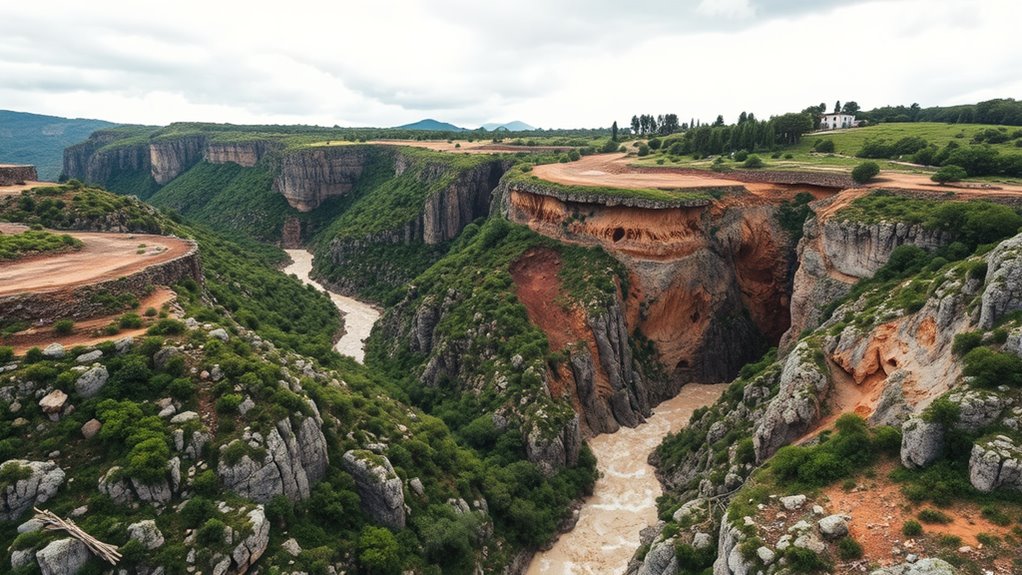
Floods and landslides in Sardinia have a well-documented history of recurring and severe events, driven by the region’s unique climate and terrain. These hazards often strike during late autumn and winter, with November producing the highest number of landslides between 2002–2021. Major events, like the 2013 Olbia flood, caused fatalities and widespread damage. Regional patterns show rapid flash floods and slow river flooding, especially in mountainous and coastal areas. The table below highlights key events:
| Year | Location | Impact | Cause |
|---|---|---|---|
| 2013 | Olbia | 18 deaths, destruction | Torrential rain, flooding |
| 2020 | Galtelli | Flooding, landslides | Cyclone, heavy rainfall |
| 2025 | Sardinia | 1 death, injuries | Flash flood, 100mm+ rain |
| 2021 | Eastern Sardinia | Infrastructure damage | Severe storms |
Additionally, the region’s terrain and climate contribute significantly to the frequency and severity of these events, often resulting in rapid flash floods that can cause sudden and devastating damage.
Changes in Disaster Preparedness and Response

Following the devastating floods and landslides documented in recent years, Sardinia has markedly enhanced its disaster preparedness and response strategies. You’ll notice these improvements through:
- Upgraded centralized emergency centers that coordinate multiple agencies, ensuring a quicker, unified response. These centers now incorporate integrated communication systems that facilitate faster decision-making during crises.
- Expanded cross-sector partnerships, including forest police, the Red Cross, and local teams, to manage evacuations and relief efforts.
- Advanced early warning systems with real-time meteorological data, GIS mapping, and modern communication platforms that deliver rapid alerts via radio, TV, and social media.
- The implementation of early warning systems has significantly improved the timely dissemination of alerts, helping residents evacuate more efficiently and reduce casualties.
These measures help you stay informed and prepared. Enhanced infrastructure, like reinforced flood defenses and modern firefighting tools, further boosts Sardinia’s resilience, ensuring that when disaster strikes, the response is swift and effective.
Comparing Sardinia’s Risks to Broader Italian Context
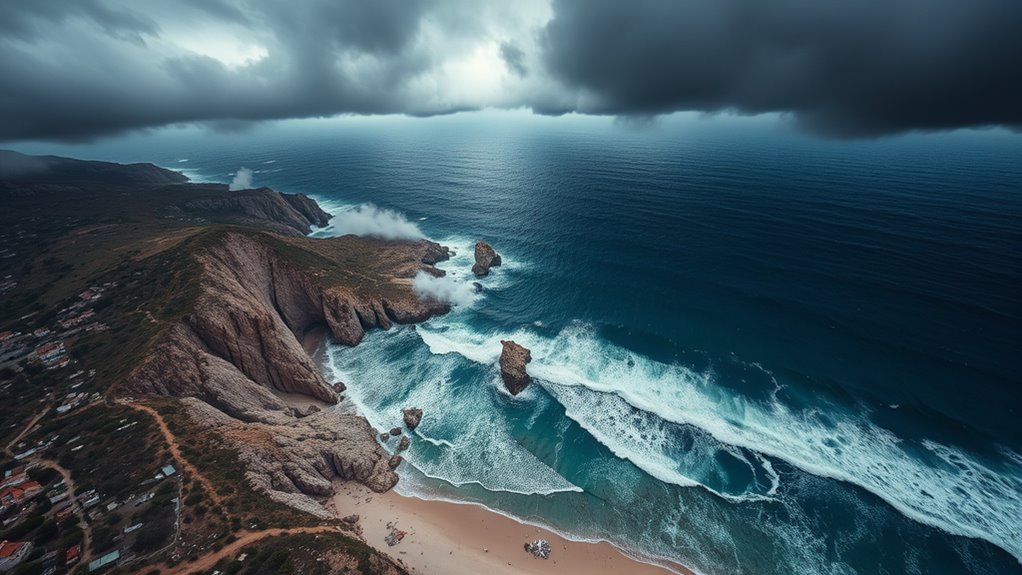
While Italy faces significant natural disaster risks across its regions, Sardinia’s hazard profile stands out for its relative stability. You’ll find that Sardinia experiences fewer earthquakes, landslides, and floods than mainland Italy. Its seismic activity is low, with only minor events recorded, whereas northern Italy endures over 30,000 stronger quakes. Wildfires are frequent but mostly localized, with an average of 2,500 annually, mainly from June to September. Fatalities are rare, averaging just over one per year. The table below highlights key differences:
| Risk Type | Sardinia | Broader Italy |
|---|---|---|
| Earthquakes | Low seismic activity | Over 30,000 medium-strong quakes recorded |
| Wildfires | Frequent, smaller scale | Larger economic and social impacts |
| Landslides & Floods | Low risk | Significant damage, thousands affected |
| Fatalities | Few, average 1.02/year | Over 50,000 historically affected |
| Economic Impact | Limited to forestry and agriculture | Major costs, infrastructure damage |
Furthermore, Sardinia’s fewer natural disasters contribute to its reputation as a relatively safe region within Italy, with a lower overall disaster risk compared to the mainland.
Frequently Asked Questions
Are Tsunamis a Significant Threat to Sardinia?
Tsunamis aren’t the biggest threat to Sardinia, but they still pose a real risk. You should be aware that moderate tsunamis, with waves over 1 meter, can happen after regional earthquakes. While these waves typically aren’t as destructive as in other parts of Italy, they could still cause damage, especially along low-lying coastlines. Staying informed and prepared ensures you’re ready for any potential tsunami events.
Has Climate Change Increased Wildfire Frequency in Sardinia?
Climate change has indeed increased wildfire risk in Sardinia. You’ll notice that higher temperatures, more frequent heatwaves, and prolonged droughts make the region’s fuels drier and more flammable. While the total number of fires might fluctuate, the severity and size of large wildfires tend to grow under these hotter, drier conditions. So, climate change amplifies wildfire intensity, making fire seasons more dangerous and challenging to manage.
What Ancient Myths Relate to Sardinia’S Natural Disasters?
Imagine hearing legends as you explore Sardinia’s rugged landscapes, where myths echo natural disasters. You might learn of a comet creating a massive wave around 1175 BC, inspiring tales of Atlantis. Or, you could hear of St. Peter battling a monster in Su Sterru Cave, symbolizing seismic shifts. These stories, like the Devil’s Saddle or Su Scultone, vividly connect natural upheavals to myth, revealing Sardinia’s deep spiritual bond with its fiery, earthquake-prone terrain.
How Does Sardinia’S Seismic Risk Compare to Mainland Italy?
You’ll find that Sardinia’s seismic risk is much lower than mainland Italy’s. While Italy experiences frequent, sometimes powerful earthquakes, Sardinia remains largely seismically quiet, with rare, low-magnitude tremors. Its geological stability means minimal damage and risk. You won’t need to worry about major seismic events there, unlike in regions along the Apennines or Calabria, where earthquakes are more common and pose greater threats.
Are Floods a Major Concern in Sardinian Urban Areas?
Like storms brewing on the horizon, floods pose a serious threat to Sardinian cities. You should know that recent events, especially in 2013, flooded streets, damaged homes, and displaced thousands. Poor drainage systems and intense rainfall make urban areas vulnerable. Without better planning and infrastructure, this risk will only grow, putting your community’s safety and economy at stake. Floods aren’t just natural events—they’re warnings to strengthen Sardinia’s urban defenses.
Conclusion
As you explore Sardinia’s history of natural disasters, you see a landscape shaped by fire, water, and earth’s unpredictable moods. These events, like whispers from the past, remind you that nature’s power is relentless and ever-present. By understanding these stories, you’re better equipped to respect its fury and cherish its beauty, knowing that Sardinia’s resilience is woven into every scar and sunrise. The island’s story is a chronicle to nature’s enduring, wild rhythm.
